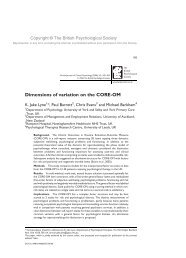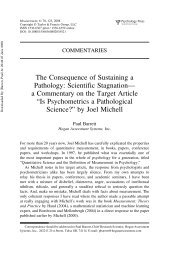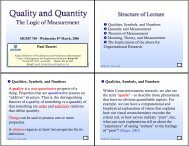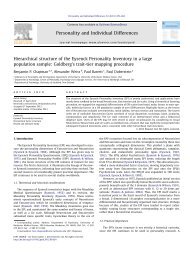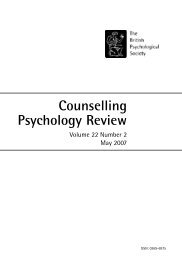Psychophysiological Methods - Paul Barrett
Psychophysiological Methods - Paul Barrett
Psychophysiological Methods - Paul Barrett
- No tags were found...
You also want an ePaper? Increase the reach of your titles
YUMPU automatically turns print PDFs into web optimized ePapers that Google loves.
Breakwell-3389-Reference.qxd 2/7/2006 9:03 PM Page 500Nesselroade, J. R. & Cattell, R. B. (Eds) (1988). Handbook of multivariate experimentalpsychology (2nd edn). London: Plenum.Neugebauer, H. (1929). Das Gefühls- und Willensleben meines Sohnes in seiner frühenKindheit. Zeitschrift für Angewandte Psychologie, 34, 275–310.Nezlek, J. B. (1991). Self-report diaries in the study of social interaction. ContemporarySocial Psychology, 14(4), 205–210.Nigro, G. & Wolpow, S. (2004). Interviewing young children with props. Applied CognitivePsychology, 18, 549–565.Nishisato, S. (1980). Analysis of categorical data: Dual scaling and its applications.Toronto: University of Toronto Press.Nitko, A. J. (1988). Designing tests that are integrated with instruction. In R. L. Linn (Ed.),Educational measurement. New York: Macmillan.Nunnally, J. C. (1978). Psychometric theory. New York: McGraw-Hill.Nunnally, J. C. & Bernstein, I. (1994). Psychometric theory. New York: McGraw-Hill.O’Brien, K. (1993). Improving survey questionnaires through focus groups. InD. L. Morgan (Ed.), Successful focus groups: Advancing the state of the art. London: Sage.Oldroyd, D. (1986). The arch of knowledge: An introductory study of the history of thephilosophy and methodology of science. New York: Methuen.Oostenveld, R. & Praamstra, P. (2001). The five percent electrode system for high-resolutionEEG and ERP measurements. Clinical Neurophysiology, 112, 713–719.Oppenheim, A. N. (1992). Questionnaire design, interviewing and attitude measurement.London: Pinter.O’Reilly, K. (2004). Ethnographic methods. London: Routledge.Palmer, R. (1969). Hermeneutics. Evanston, IL: Northwestern University Press.Park, R. E. (1967). On social control and collective behaviour: Selected papers. Chicago:University of Chicago Press.Parker, I. (1992). Discourse dynamics: Critical analysis for social and individual psychology.London: Routledge.Parker, I. (1997). Discourse analysis and psychoanalysis. British Journal of SocialPsychology, 36, 479–495.Parker, I. & Burman, E. (1993). Against discursive imperialism, empiricism and constructionism:Thirty-two problems with discourse analysis. In E. Burman & I. Parker(Eds), Discourse analytic research: Repertoires and readings of texts in action.London: Routledge.Parker, I., Georgaca, E., Harper, D., McLaughlin, T. & Stowell-Smith, M. (1995).Deconstructing psychopathology. London: Sage.Parkes, C. M. (1971). Psycho-social transitions: A field for study. Social Science andMedicine, 5, 101–115.Pashler, H. & Wixted, J. (Eds) (2002). Methodology in experimental psychology.Chichester: Wiley.Pearson, K. (1904). Report on certain enteric fever inoculation statistics. British MedicalJournal, 3, 1243–1246.Pelli, D. G. & Farell, B. (1995). Psychophysical methods. In M. Bass (Ed.), Handbook ofoptics, Vol. I (2nd edn). New York: McGraw-Hill.Pentland, A. (1980). Maximum likelihood estimation: The best PEST. Perception &Psychophysics, 28, 377–379.500 RESEARCH METHODS IN PSYCHOLOGY



